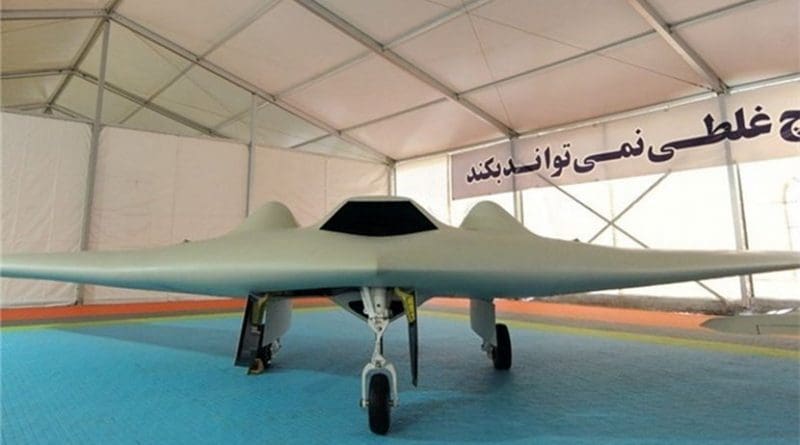Drone Technology Driving Iran’s Asymmetric Warfare – Analysis
The Iranian-supplied drone attacks carried out by the Houthis on Saudi energy infrastructure on Tuesday are an immediate concern for all supporters. Here, the Houthis, who the same day had finished observing the Stockholm process for clearing out the port of Hodeidah, launched Tehran’s drones into Saudi Arabia. For some, that is a direct attack by the Islamic Republic of Iran. There is a much bigger picture to understand when it comes to Iranian-backed attacks on energy infrastructure, and Tehran’s dangerous games in the face of mounting economic pressure and international isolation are a warning of what is to come.
Iran’s drone doctrine is based on asymmetric warfare. Most people focus on governments deploying drones, but terrorists, insurgents and other non-state actors are using them as well. Hezbollah has been operating Iranian-built drones against Israel for years, but these have been predominantly military-grade models and thus fairly sophisticated. To be clear, Hezbollah acquires advanced models from Iran and is one of only 10 entities that have fired missiles from a drone at targets on the ground. The other nine are all countries, not violent non-state actors.
Iran uses its drones in what should now be seen as a very threatening manner. In March, the Islamic Revolutionary Guard Corps (IRGC) held a drill codenamed “Towards Jerusalem 1” near the strategic Strait of Hormuz. It flew about 50 “offensive and combat” drones to the Arabian Gulf, including “Saegheh” unmanned combat aerial vehicles, which are based on the American RQ-170 that Tehran captured a few years ago and that it was able to duplicate to use against the US’ Arab partners. The drones took off from bases up to about 1,000 kilometers from the targets on Bani Farur island and successfully bombed them. It was the first time such a high number of offensive drones had participated in a drill.
In Yemen, the story is a continuation of the Iranian model. The Houthis have made effective use of drones in their fight against government forces and the Saudi-led coalition. They have struck targets inside and outside Yemen with ballistic missiles, with US-supplied Patriot missile batteries being the primary defense against these attacks. But drones have not only appeared in the air — Houthi forces have also conducted attacks on coastal shipping using remotely controlled explosive “drone boats.” The most significant example was an attack on a Saudi frigate in January 2017.
Now the threat against energy assets from Iran and its proxies in terms of asymmetric warfare through the use of drones is only growing. Culture seems to be a driver in Iran’s use of drones. The 1990 movie “Mohajer,” based on a true story, depicted the start of drone operations in Iran during the closing years of the Iraqi-imposed war of the 1980s. The Qods Mohajer drone first flew in 1985, so Iranian experience with drones is neither unknown nor new.
The Iranian armed forces actually started using unmanned aerial vehicles (UAVs), including drones, at around that time, mostly for intelligence gathering, including imaging, and bombing operations.
Now we live in a more combative time, as Iran shows off its networks and ability to spread technology in response to increasing sanctions affecting the country’s economic sectors. Iranian forces are using drones for every possible mission, from logistics to surveillance, and probably soon airstrikes with payload. Iran deploys surveillance and armed drones in its border areas, including for reconnaissance and target identification, as well as in the neighboring countries in which it is militarily involved, like Iraq and Syria. Moreover, with Houthi successes, strikes on energy infrastructure by Iran and its proxies appear to be a well-structured model for targeting such assets in the immediate future. That Iran and its proxies can use such asymmetric tactics, which cover land and sea, brings into focus the threat from such technology in Tehran’s hands.
Geographically, the reach of such Iranian-based asymmetric tools is problematic because of the way Iran is teaching its proxies, or how its proxies modify and adapt, to use drones and other technology against energy infrastructure or transport. Saudi Arabia and the UAE are primary asymmetric targets because of Iran and its proxies’ modus operandiand their proximity.
Unfortunately, the spread of such technology, which can strike other energy infrastructure, is likely because of the ease of transportation, assembly, launching and striking of energy-related targets. Iran’s global network, supported by Hezbollah, is a primary threat and allies of both exist in West Africa and Latin America. The ideal targets for Iran and its proxies remain oil pipelines, certain oil export infrastructure and oil industry personnel that are close to any locations from where drones can be launched. Other target sites include utilities and electric power plants. Wellheads will still be a target but, thanks to drone technology, bigger targets with higher psychological impacts loom. The US’ designation of the IRGC as a Foreign Terrorist Organization is part of the attempts to try to mitigate the spread of such technology. Indeed, Iran is playing a dangerous game as President Donald Trump’s maximum pressure campaign continues.

